The Distribution Characteristics and Potential Risk Assessment of Lead in the Soil of Tieguanyin Tea Plantations in Anxi County, China
Abstract
:1. Introduction
2. Materials and Methods
2.1. Overview of Study Area
2.2. Sample Collection and Processing
2.3. Methods of Analysis
2.4. Potential Ecological Hazard Index
2.5. Data Processing
3. Results
3.1. Tea Plantation Soil Lead Content
3.1.1. Soil Lead Content in Various Rock Formations
3.1.2. Soil Lead Content of Tea Plantations in Different Townships
3.1.3. Spatial Distribution of Soil Lead in Tea Plantation
3.2. Ecological Risk Evaluation of Lead in Tea Plantation Soil
3.2.1. Evaluation Based on the Soil Environmental Quality Standard
3.2.2. Evaluation Based on the Environmental and Technical Conditions of Tea Production Areas
3.2.3. Evaluation Based on the Environmental and Technical Conditions of Organic Tea Production Areas
3.2.4. Evaluation of Potential Ecological Risk
3.3. Relationship between Soil Lead Content and Factors in Tea Plantation
4. Discussion
4.1. Distribution Characteristics and Source Analysis of Soil Lead Content in Tea Plantation
4.2. Potential Risks and Early Warning concerning Soil Lead in Tea Plantation
5. Conclusions
- (1)
- The lead content in soils developed from the three major rock types was generally lower than the background soil element value in the Fujian Tieguanyin tea plantation. Only the average lead content in soils derived from andesite in magmatic rocks exceeded the background value of soil elements in the Fujian Tieguanyin tea plantation. The average soil lead content developed by these rock types is higher than the national background value.
- (2)
- The soil lead content in Tieguanyin tea plantations within the townships of Huqiu, Kuidou, Lutian, Bailai, and Hushang exceeded the background value of soil elements in Tieguanyin tea plantations in Fujian. Except for Futian, other townships of Anxi County’s Tieguanyin tea plantations exhibited a soil lead content higher than the national background value of soil elements. The distribution of soil lead in Anxi County’s Tieguanyin tea plantations was uneven and significantly impacted by external factors.
- (3)
- The soil lead content of the Tieguanyin tea plantations of Anxi County gradually declined from the center to the east and west, forming four distinct parallel distribution zones in the north–south direction. High-lead-content areas occurred at the convergence of Jiandou, Bailai, and Hushang; in Lutian’s central region; and in the southern part of Huqiu. The distribution of available lead content in the tea plantation soil of Anxi County was consistent with the lead content distribution.
- (4)
- The spatial distribution map of potential ecological hazard indexes, based on the background values of the Soil Environmental Quality Standard, Environmental Technical Conditions for Tea Production Area, and Environmental Technical Conditions for Organic Tea Production Area, indicated that the soil lead pollution in the Tieguanyin tea plantations of Anxi County was at a low level, posing no risk of potential pollution. Part of the soil lead in the Tieguanyin tea plantations of Anxi County originates from the soil parent rock, but a larger portion is attributed to automobile exhaust, atmospheric deposition, and agricultural activities, with automobile exhaust being the more likely source.
Author Contributions
Funding
Institutional Review Board Statement
Informed Consent Statement
Data Availability Statement
Conflicts of Interest
References
- Rai, P.K.; Lee, S.S.; Zhang, M.; Tsang, Y.F.; Kim, K.H. Heavy metals in food crops: Health risks, fate, mechanisms, and management. Environ. Int. 2019, 125, 365–385. [Google Scholar] [CrossRef] [PubMed]
- Kamil, J.; Elzbieta, K.P.; Miroslaw, K. The Control and Comprehensive Safety Assessment of Heavy Metal Impurities (As, Pb, and Cd) in Green Tea Camellia sinensis (L.) Samples (Infusions) Available in Poland. Biol. Trace Elem. Res. 2023, 1–10. [Google Scholar] [CrossRef]
- Khalid, S.; Shahid, M.; Niazi, N.K.; Murtaza, B.; Bibi, I.; Dumat, C. A comparison of technologies for remediation of heavy metal contaminated soils. J. Geochem. Explor. 2017, 182, 247–268. [Google Scholar] [CrossRef]
- Kumar, V.; Sharma, A.; Kumar, R.; Bhardwaj, R.; Kumar, T.A.; Rodrigo, C.J. Assessment of heavy-metal pollution in three different Indian water bodies by combination of multivariate analysis and water pollution indices. Hum. Ecol. Risk Assess. 2020, 26, 1–16. [Google Scholar] [CrossRef]
- Yemane, M.; Chandravanshi, B.S.; Wondimu, T. Levels of essential and non-essential metals in leaves of the tea plant (Camellia sinensis L.) and soil of Wushwush farms, Ethiopia. Food Chem. 2008, 107, 1236–1243. [Google Scholar] [CrossRef]
- Zhang, Z.Y.; Deng, Q.M.; Ye, H.; Ge, G.F. Bacterial and fungal diversities examined through high-throughput sequencing in response to lead contamination of tea garden soil. Front. Microbiol. 2023, 14, 1121199. [Google Scholar] [CrossRef]
- Li, Y.; Liu, K.H.; Zhu, J.; Jiang, Y.R.; Huang, Y.Y.; Zhou, Z.M.; Chen, C.S.; Yu, F.M. Manganese accumulation and plant physiology behavior of Camellia oleifera in response to different levels of nitrogen fertilization. Ecotoxicol. Environ. Saf. 2019, 184, 109603. [Google Scholar] [CrossRef]
- Zhang, J.; Yang, R.; Li, Y.C.; Peng, Y.; Wen, X.; Ni, X. Distribution, accumulation, and potential risks of heavy metals in soil and tea leaves from geologically different plantations. Ecotoxicol. Environ. Saf. 2020, 195, 110475. [Google Scholar] [CrossRef]
- Sun, J.W.; Hu, G.R.; Liu, K.K.; Yu, R.L.; Lu, Q.Y.; Zhang, Y.F. Potential exposure to metals and health risks of metal intake from Tieguanyin tea production in Anxi, China. Environ. Geochem. Health 2019, 41, 1291–1302. [Google Scholar] [CrossRef]
- Cong, Y.; Yu, R.L.; Yan, Y.; Weng, B.S.; Hu, G.R.; Sun, J.W.; Cui, J.Y.; Yan, Y.; Huang, Y.Y. Source analysis of metals in the tea plant using linear correlation analysis combined with a lead-strontium isotope tracer. Catena 2023, 229, 107194. [Google Scholar] [CrossRef]
- Zhang, W.H.; Yan, Y.; Yu, R.L.; Hu, G.R. The sources-specific health risk assessment combined with APCS/MLR model for heavy metals in tea garden soils from south Fujian Province, China. Catena 2021, 203, 105306. [Google Scholar] [CrossRef]
- Sun, J.; Yu, R.; Yan, Y.; Hu, G.; Qiu, Q.; Jiang, S.; Cui, J.; Wang, X.; Ma, C. Isotope tracers for lead and strontium sources in the Tieguanyin tea garden soils and tea leaves. Chemosphere 2020, 246, 125638. [Google Scholar] [CrossRef] [PubMed]
- Research Office of Party History and Local History of Anxi County Committee of the Communist Party of China. Anxi County Yearbook; Strait Literature and Art Publishing House: Fuzhou, China, 2020. [Google Scholar]
- Yang, L.; Ge, S.J.; Liu, J.H.; Iqbal, Y.; Jiang, Y.L.; Sun, R.L.; Ruan, X.L.; Wang, Y.Y. Spatial Distribution and Risk Assessment of Heavy Metal(oid)s Contamination in Topsoil around a Lead and Zinc Smelter in Henan Province, Central China. Toxics 2023, 11, 427. [Google Scholar] [CrossRef] [PubMed]
- Ahamad, A.; Janardhana, R.N.; Madhav, S.; Gossel, W.; Ram, P.; Wycisk, P. Potentially toxic elements in soil and road dust around Sonbhadra industrial region, Uttar Pradesh, India: Source apportionment and health risk assessment. Environ. Res. 2021, 202, 111685. [Google Scholar] [CrossRef] [PubMed]
- Hakanson, L. An ecological risk index for aquatic pollution control. A sedimentological approach. Water Res. 1980, 14, 975–1001. [Google Scholar] [CrossRef]
- He, H.F.; Shi, L.Q.; Yang, G.; You, M.S.; Vasseur, L. Ecological Risk Assessment of Soil Heavy Metals and Pesticide Residues in Tea Plantations. Agriculture 2020, 10, 47. [Google Scholar] [CrossRef]
- Sarmah, M.; Borgohain, A.; Gogoi, B.B.; Yeasin, M.; Paul, R.K.; Malakar, H.; Handique, J.G.; Saikia, J.; Deka, D.; Khare, P.; et al. Insights into the effects of tea pruning litter biochar on major micronutrients (Cu, Mn, and Zn) pathway from soil to tea plant: An environmental armour. J. Hazard. Mater. 2023, 442, 129970. [Google Scholar] [CrossRef]
- Wei, F.S. Background Values of Soil Elements in China; China Environmental Science Press: Beijing, China, 1990. [Google Scholar]
- Zhou, G.H.; Zeng, D.M.; He, L.; Zhu, X.T.; Sun, B.B.; Bai, J.F.; Zhou, Z.Q. Ecogeochemical characteristics of Tieguanyin Tea Garden in Fujian Province. Geol. China 2015, 42, 2008–2018. [Google Scholar]
- GB 15618-2018; Ministry of Ecology and Environment, State Administration for Market Regulation. Soil Environmental Quality, Agricultural Land Soil Pollution Risk Control Standards (Trial). Standards Press of China: Beijing, China, 2018.
- NY/T 853-2004; Environmental and Technical Conditions of Tea Producing Areas. Ministry of Agriculture of the People’s Republic of China: Beijing, China, 2004.
- NY 5199-2002; Environmental Conditions of Organic Tea Producing Areas. Ministry of Agriculture of the People’s Republic of China: Beijing, China, 2002.
- Stafilov, T.; Šajn, R. Spatial distribution and pollution assessment of heavy metals in soil from the Republic of North Macedonia. J. Environ. Sci. Health A 2019, 54, 1457–1474. [Google Scholar] [CrossRef]
- Weng, K.; Dong, Y.P.; Xu, X.Y.; Ma, Z.P.; Chen, B.; Cao, K. Geochemistry and geochronology of Carboniferous magmatic rocks in the Sawur Mountains, northern West Junggar, NW China: Implications for accretionary orogeny. Int. J. Earth Sci. 2020, 109, 605–630. [Google Scholar] [CrossRef]
- Basua, A.A.E.; Ma, C.Q.; Nguo, K.S.; Wang, L.X.; Lentz, D.R.; Mukherjee, S.; Signe, N.N.S.; Syprien, B.Y. Petrogenesis and tectonic setting of A-type granites in the Babouri-Figuil Magmatic Complex (North Cameroon): Constraints from whole rock geochemistry, zircon UPb geochronology and Sr-Nd-Hf isotopes. Lithos 2022, 414, 106618. [Google Scholar] [CrossRef]
- Andonaegui, P.; Abati, J.; Ruben, D.F. Late Cambrian magmatic arc activity in peri-Gondwana: Geochemical evidence from the Basal Allochthonous Units of NW Iberia. Geol. Acta 2017, 15, 305–321. [Google Scholar]
- Ahankoub, M.; Asahara, Y.; Tsuboi, M. Petrology and geochemistry of the Lattan Mountain magmatic rocks in the Sanandaj–Sirjan Zone, west of Iran. Arab. J. Geosci. 2020, 13, 809. [Google Scholar] [CrossRef]
- Li, Q.H.; Li, C.F.; Liu, L.J.; Heng, W.; Chen, C.; Long, J.; Wen, X.F. Geochemical characteristics of heavy metals of bedrock, soil, and tea in a metamorphic rock area of Guizhou Province, China. Environ. Sci. Pollut. Res. 2022, 30, 7402–7414. [Google Scholar] [CrossRef] [PubMed]
- Guo, G.H.; Li, K.; Zhang, D.G.; Lei, M. Quantitative source apportionment and associated driving factor identification for soil potential toxicity elements via combining receptor models, SOM, and geo-detector method. Sci. Total Environ. 2022, 830, 154721. [Google Scholar] [CrossRef]
- Cao, H.L.; Cai, F.Y.; Jiao, W.B.; Liu, C.; Zhang, N.; Qiu, H.Y.; Rensing, C.; Lü, J. Assessment of tea garden soils at An’xi County in southeast China reveals a mild threat from contamination of potentially harmful elements. R. Soc. Open Sci. 2018, 5, 180050. [Google Scholar] [CrossRef]
- Wang, S.; Cai, L.M.; Wen, H.H.; Luo, J.; Wang, Q.S.; Liu, X. Spatial distribution and source apportionment of heavy metals in soil from a typical county-level city of Guangdong Province, China. Sci. Total Environ. 2019, 655, 92–101. [Google Scholar] [CrossRef]
- Fan, S.X.; Wang, X.D.; Lei, J.; Ran, Q.Q.; Ren, Y.X.; Zhou, J.H. Spatial distribution and source identification of heavy metals in a typical Pb/Zn smelter in an arid area of northwest China. Hum. Ecol. Risk Assess. 2019, 25, 1661–1687. [Google Scholar] [CrossRef]
- Williams, C.; David, D. The effect of superphosphate on the cadmium content of soils and plants. Soil. Res. 1973, 11, 43–56. [Google Scholar] [CrossRef]
- Lin, W.W.; Lin, M.H.; Zhou, H.Y.; Wu, H.M.; Li, Z.W.; Lin, W.X. The effects of chemical and organic fertilizer usage on rhizosphere soil in tea orchards. PLoS ONE 2019, 14, e0217018. [Google Scholar] [CrossRef]
- Yi, X.Y.; Ji, L.F.; Hu, Z.M.; Yang, X.D.; Li, H.T.; Jiang, Y.Y.; He, T.H.; Yang, Y.Y.; Ni, K.; Ruan, J.Y. Organic amendments improved soil quality and reduced ecological risks of heavy metals in a long-term tea plantation field trial on an Alfisol. Sci. Total Environ. 2022, 838, 156017. [Google Scholar] [CrossRef] [PubMed]
- Zhang, M.; Fang, L. Tea Plantation-Induced Activation of Soil Heavy Metals. Commun. Soil. Sci. Plant Anal. 2007, 38, 1467–1478. [Google Scholar] [CrossRef]
- Ye, J.H.; Zhang, Q.; Liu, G.Y.; Lin, L.W.; Wang, H.B.; Lin, S.X.; Wang, Y.C.; Wang, Y.H.; Zhang, Q.X.; Jia, X.L.; et al. Relationship of soil pH value and soil Pb bio-availability and Pb enrichment in tea leaves. J. Sci. Food Agric. 2021, 102, 1137–1145. [Google Scholar] [CrossRef] [PubMed]
- Giuseppe, G.; Anna, G.; Grazia, D.; Antonio, L.; Matteo, F.; Emanuele, T.; Marcella, M.G. Irrigation with Treated Municipal Wastewater on Artichoke Crop: Assessment of Soil and Yield Heavy Metal Content and Human Risk. Water 2018, 10, 255. [Google Scholar]
- Chen, D.; Liu, X.Y.; Bian, R.J.; Cheng, K.; Zhang, X.H.; Zheng, J.F.; Joseph, S.; Crowley, D.; Pan, G.X.; Li, L.Q. Effects of biochar on availability and plant uptake of heavy metals—A meta-analysis. J. Environ. Manag. 2018, 222, 76–85. [Google Scholar] [CrossRef] [PubMed]
- Seenivasan, S.; Anderson, T.A.; Muraleedharan, N. Heavy metal content in tea soils and their distribution in different parts of tea plants, Camellia sinensis (L). O. Kuntze. Environ. Monit. Assess. 2016, 188, 428. [Google Scholar] [CrossRef]
- Tao, C.J.; Song, Y.X.; Chen, Z.; Zhao, W.F.; Ji, J.F.; Shen, N.P.; Ayoko, G.A.; Frost, R.L. Geological load and health risk of heavy metals uptake by tea from soil: What are the significant influencing factors? Catena 2021, 204, 105419. [Google Scholar] [CrossRef]
- Bourg, A.C.M.; Loch, J.P.G. Mobilization of Heavy Metals as Affected by pH and Redox Conditions; Springer: Berlin/Heidelberg, Germany, 1995; pp. 87–102. [Google Scholar]
- Xu, W.; Lan, H.C.; Wang, H.J.; Liu, H.M.; Qu, J.H. Comparing the adsorption behaviors of Cd, Cu and Pb from water onto Fe-Mn binary oxide, MnO2 and FeOOH. Front. Environ. Sci. Eng. 2015, 9, 385–393. [Google Scholar] [CrossRef]
- Balistrieri, L.S.; Murray, J.W. The surface chemistry of sediments from the panama basin: The influence of mn oxides on metal adsorption. Geochim. Cosmochim. Acta 1986, 50, 2235–2243. [Google Scholar] [CrossRef]
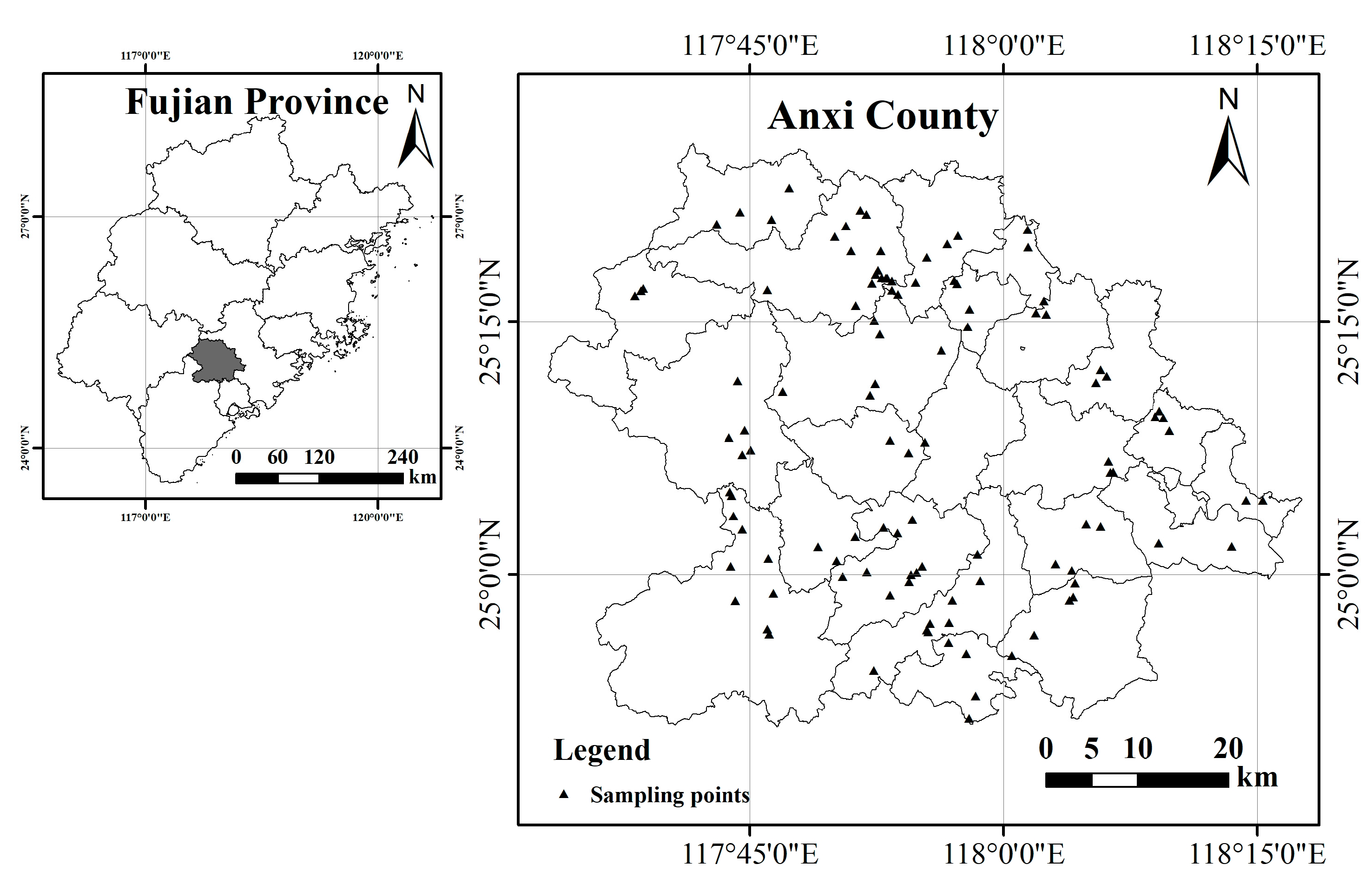
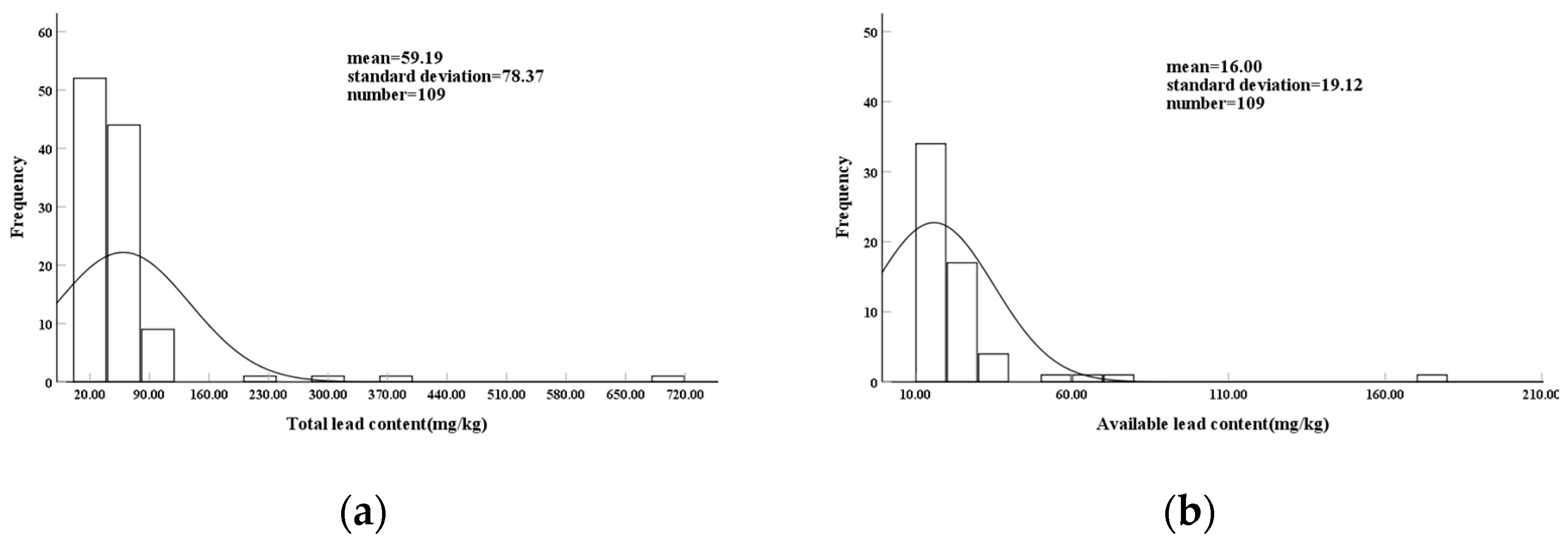
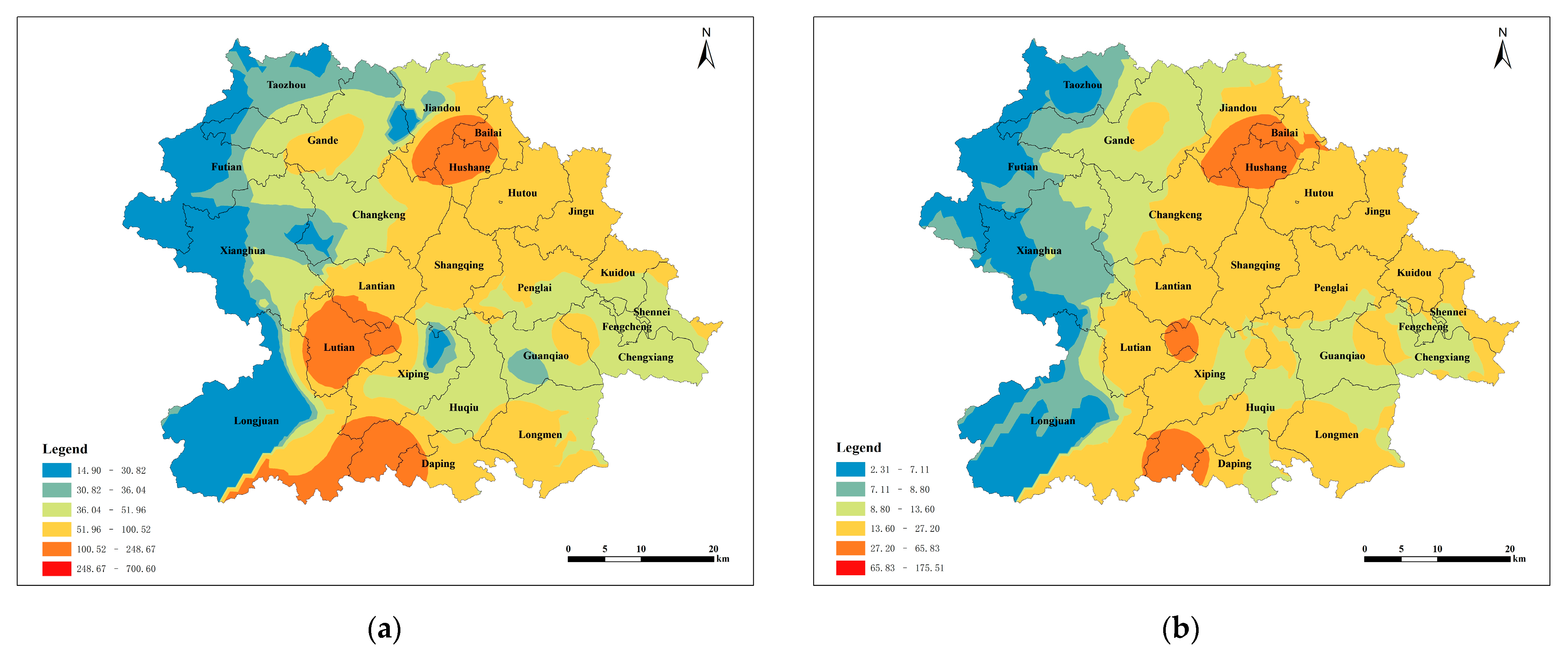
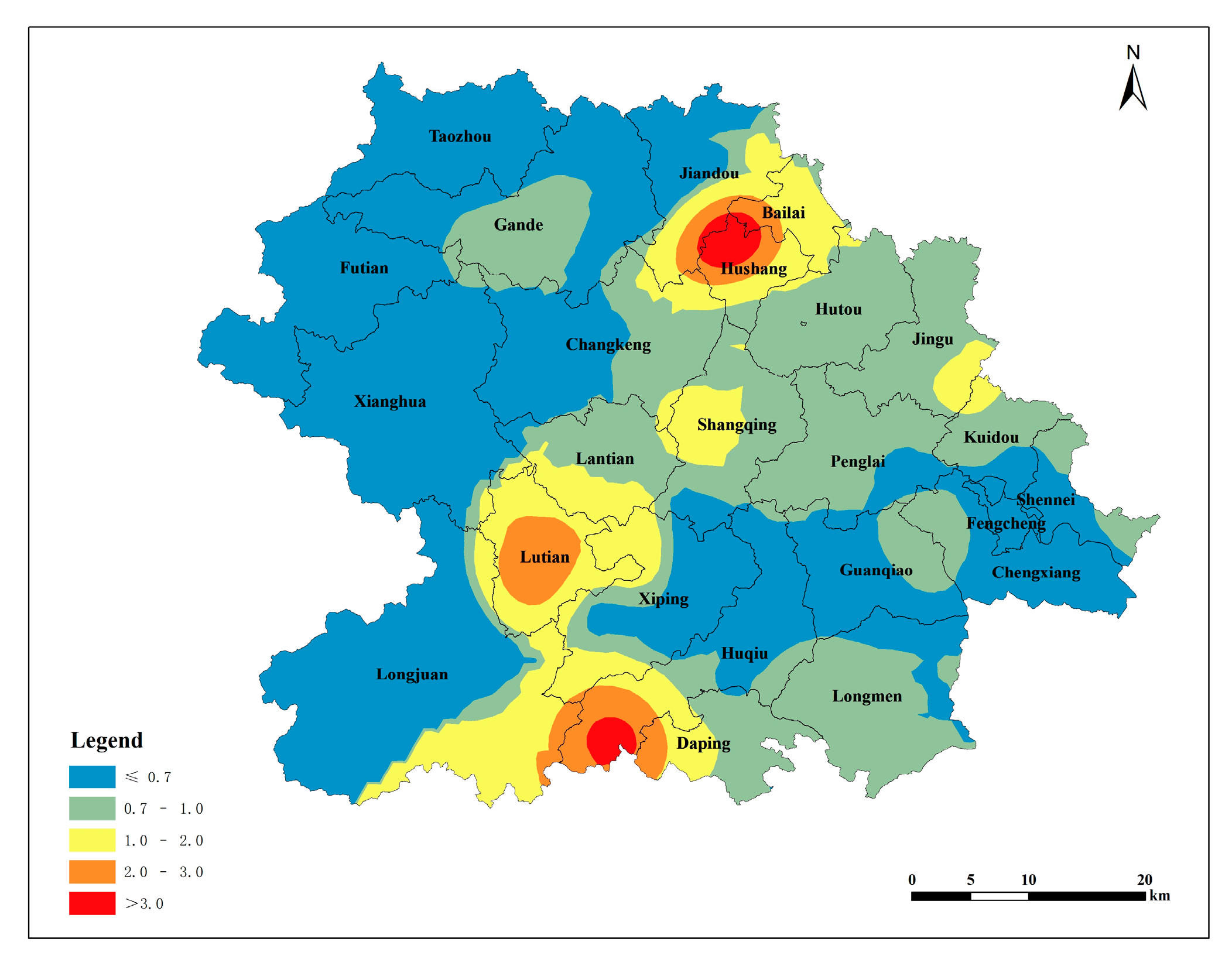
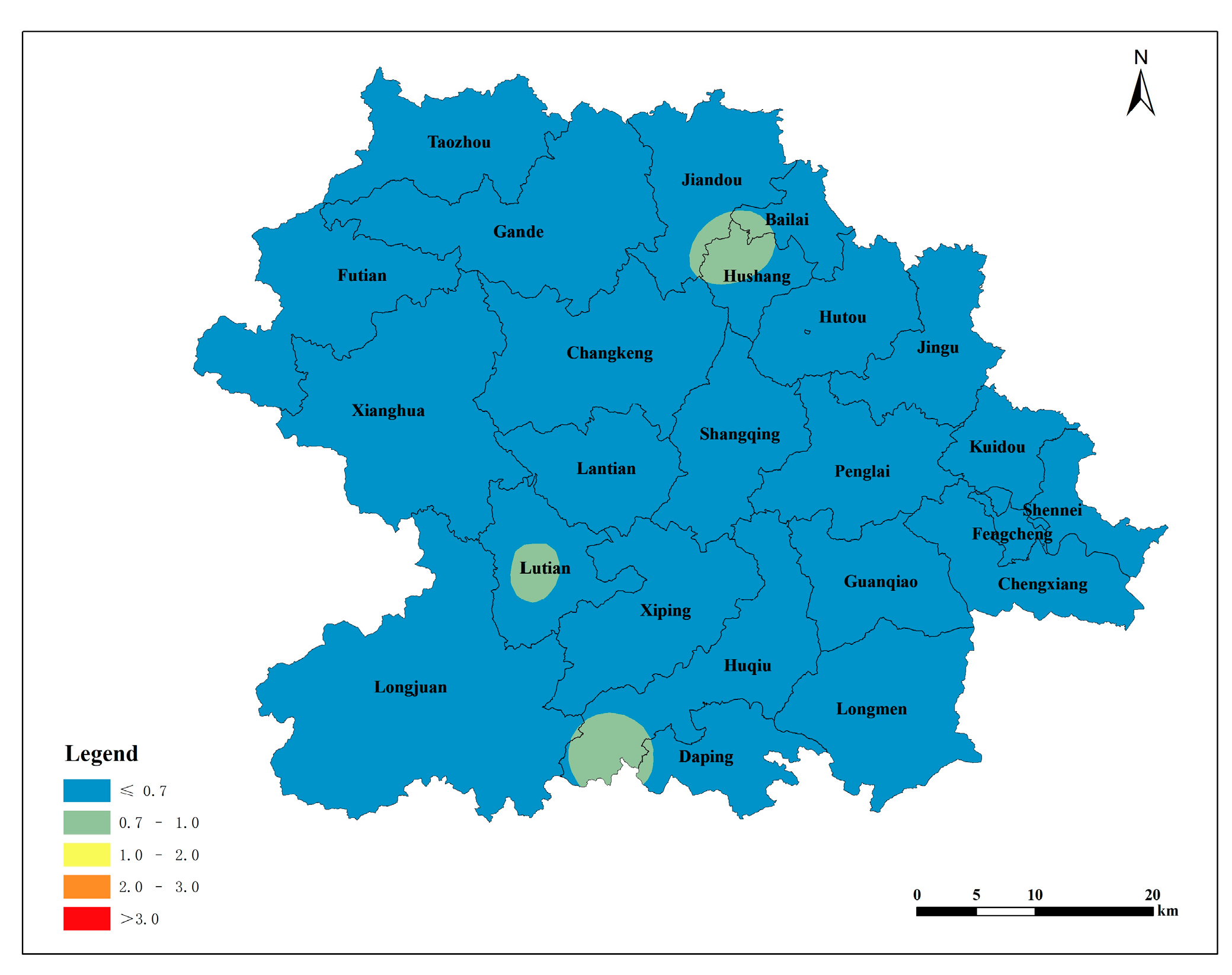
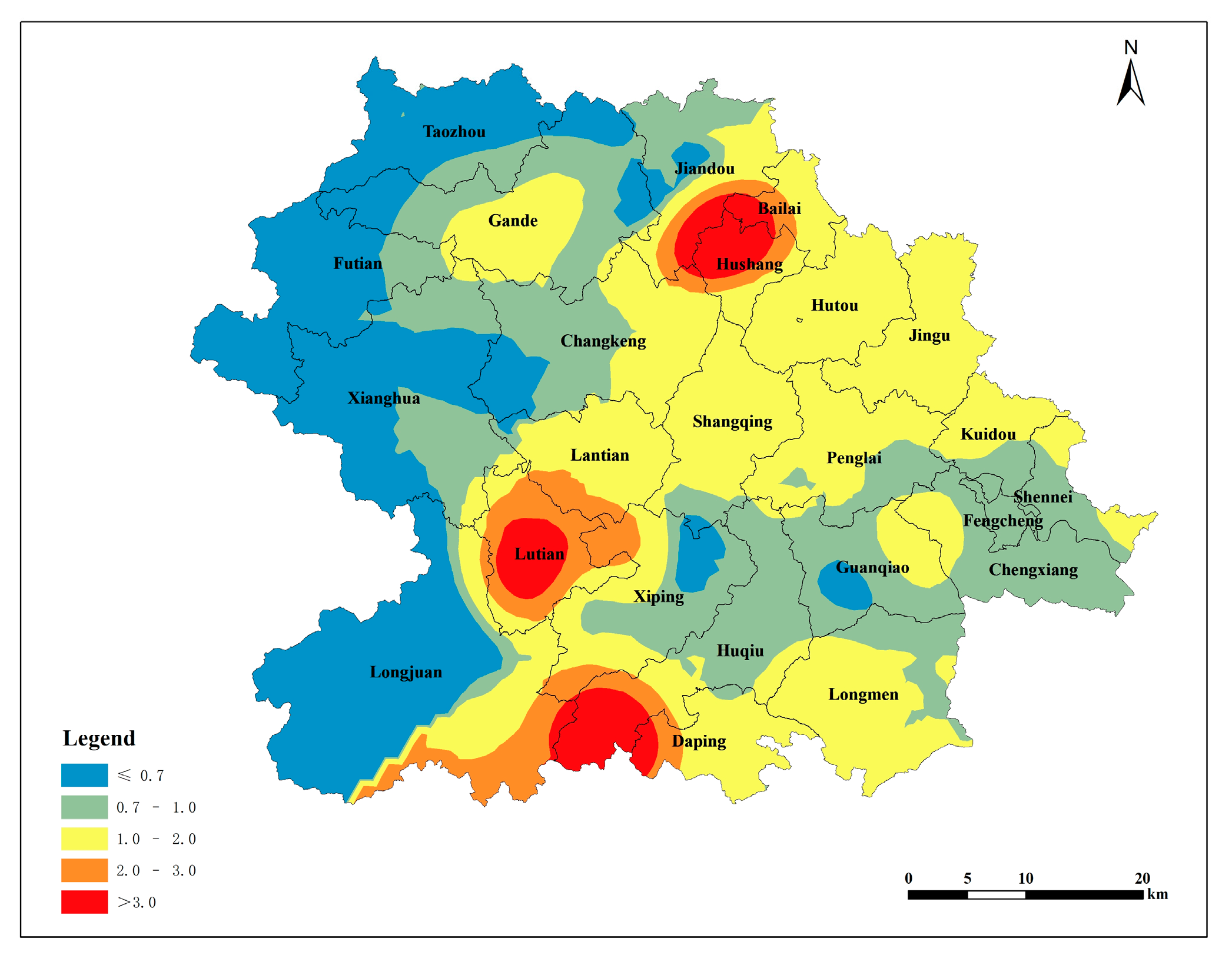
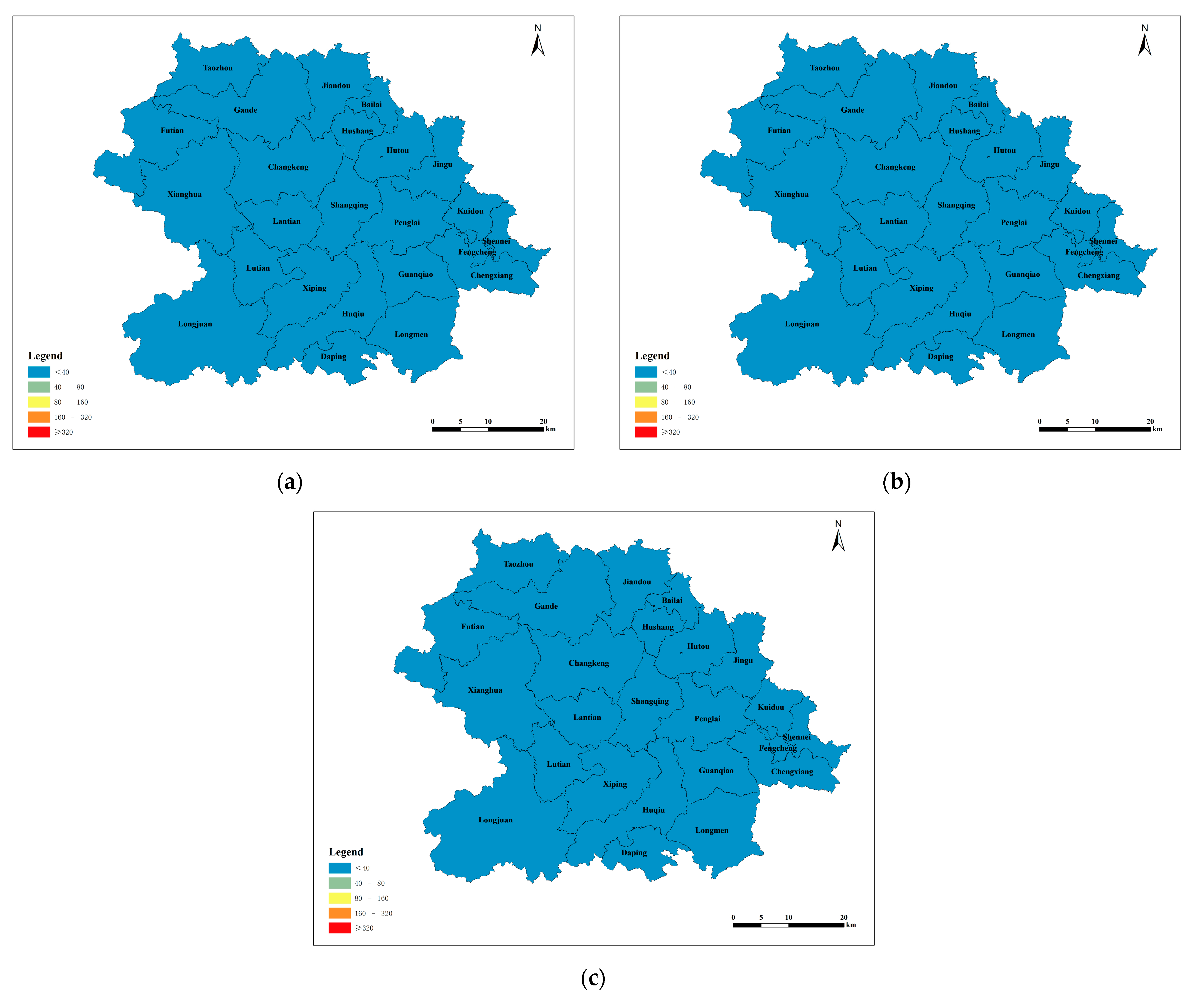
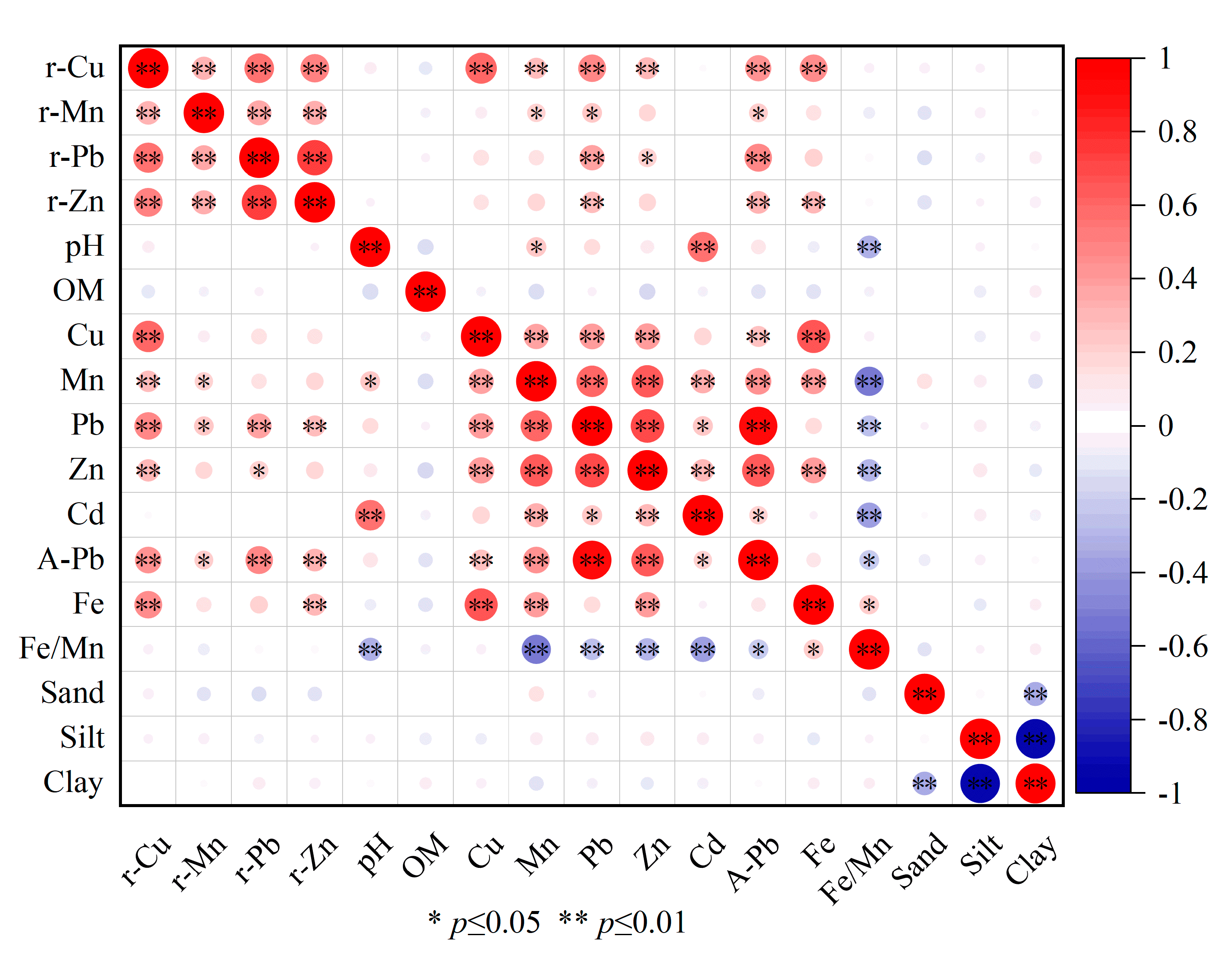
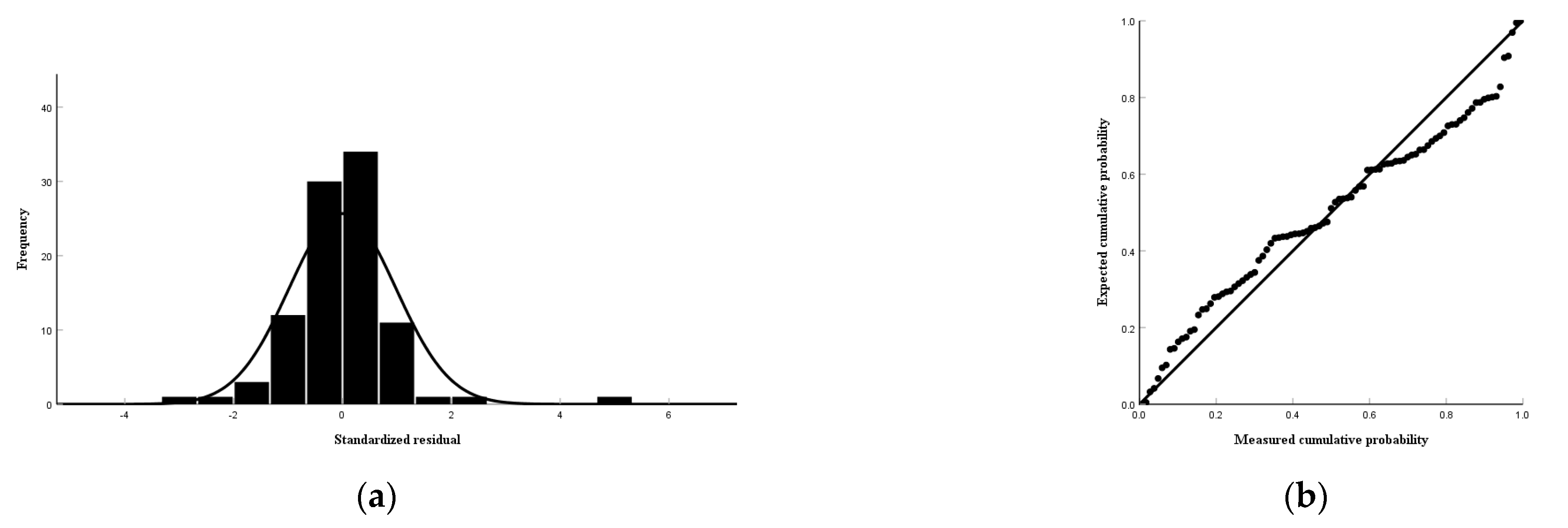
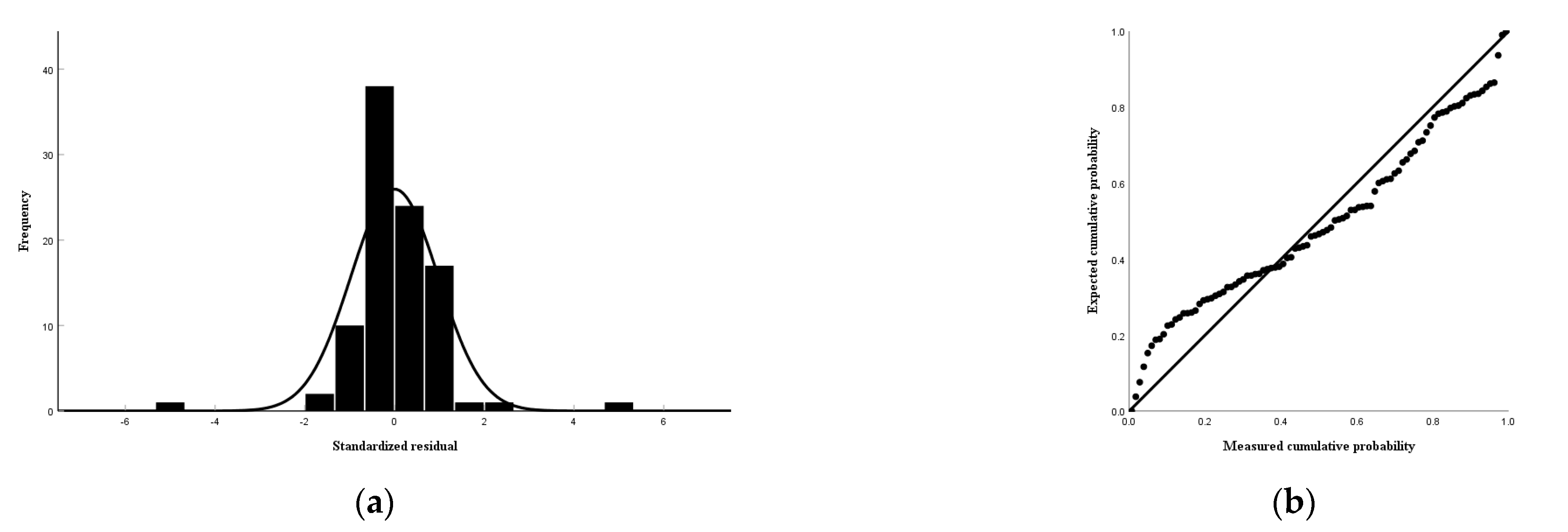
| Type | Norm | Mean | SD | CV | Min | Max |
|---|---|---|---|---|---|---|
| Rock | Cu | 9.93 | 15.07 | 1.52 | 0.30 | 82.30 |
| Mn | 750.84 | 1197.67 | 1.60 | 78.00 | 9741.00 | |
| Pb | 53.33 | 86.52 | 1.62 | 8.10 | 640.60 | |
| Zn | 84.47 | 126.77 | 1.50 | 8.90 | 1006.50 | |
| Soil | Cu | 12.38 | 9.90 | 0.80 | 0.30 | 56.7 |
| Mn | 403.38 | 377.38 | 0.94 | 65.00 | 2356.00 | |
| Zn | 71.68 | 37.28 | 0.52 | 20.90 | 262.80 | |
| Cd | 0.05 | 0.04 | 0.66 | 0.003 | 0.18 | |
| Fe | 3.38 | 1.71 | 0.51 | 1.18 | 10.64 |
| Ecological Hazard Level | Low | Medium | High | Higher | Extremely High | Toxicity Factor |
|---|---|---|---|---|---|---|
| E | <40 | 40–80 | 80–160 | 160–320 | ≥320 | 5 |
| Rock Type | Number | Mean (mg/kg) | SD | Min (mg/kg) | Max (mg/kg) | CV | |
|---|---|---|---|---|---|---|---|
| magmatic rock | andesite | 13 | 99.88 | 181.90 | 21.10 | 700.60 | 182.13% |
| rhyolite | 15 | 60.95 | 71.58 | 15.70 | 308.50 | 117.45% | |
| dacite | 43 | 62.06 | 58.22 | 15.70 | 364.70 | 93.81% | |
| granite | 20 | 50.32 | 26.45 | 14.90 | 118.20 | 52.57% | |
| Three major rock type | magmatic | 91 | 64.70 | 84.67 | 14.90 | 700.60 | 130.87% |
| metamorphic | 5 | 32.64 | 7.82 | 26.90 | 45.90 | 23.95% | |
| sedimentary | 13 | 30.88 | 9.90 | 17.00 | 53.10 | 32.06% | |
| Rock Type | A | B | C | AB | AC | |
|---|---|---|---|---|---|---|
| magmatic rock | andesite | 99.88 | 65.00 | 23.30 | 34.88 | 76.58 |
| rhyolite | 60.95 | 65.00 | 23.30 | −4.05 | 37.65 | |
| dacite | 62.06 | 65.00 | 23.30 | −2.94 | 38.76 | |
| granite | 50.32 | 65.00 | 23.30 | −14.69 | 27.02 | |
| three major rock type | magmatic | 64.70 | 65.00 | 23.30 | −0.30 | 41.40 |
| metamorphic | 32.64 | 65.00 | 23.30 | −32.36 | 9.34 | |
| sedimentary | 30.88 | 65.00 | 23.30 | −34.12 | 7.58 | |
| Study Area | Number | Lead (mg/kg) | Available Lead (mg/kg) | |||
|---|---|---|---|---|---|---|
| Mean | CV | Mean | CV | |||
| Anxi County | Daping | 4 | 50.58 ± 20.30 | 40.14% | 11.13 ± 5.69 | 51.12% |
| Guanqiao | 5 | 40.88 ± 23.56 | 57.63% | 10.53 ± 6.51 | 61.85% | |
| Huqiu | 8 | 82.25 ± 92.53 | 112.50% | 20.54 ± 16.26 | 79.14% | |
| Kuidou | 4 | 70.05 ± 20.82 | 29.72% | 22.43 ± 9.54 | 42.54% | |
| Longmen | 3 | 61.13 ± 12.41 | 20.29% | 15.64 ± 5.99 | 38.31% | |
| Penglai | 3 | 44.40 ± 12.70 | 28.60% | 12.72 ± 2.62 | 20.64% | |
| Xiping | 9 | 38.44 ± 12.58 | 32.72% | 13.60 ± 6.05 | 44.51% | |
| Lutian | 5 | 148.98 ± 147.16 | 98.78% | 28.67 ± 25.92 | 90.41% | |
| Bailai | 4 | 71.68 ± 16.10 | 22.46% | 19.97 ± 6.84 | 34.27% | |
| Gande | 15 | 39.27 ± 14.98 | 38.15% | 10.58 ± 4.75 | 44.84% | |
| Jiandou | 6 | 64.27 ± 33.89 | 52.73% | 23.70 ± 20.42 | 86.17% | |
| Jingu | 3 | 64.07 ± 5.08 | 7.93% | 13.22 ± 2.53 | 19.17% | |
| Changkeng | 5 | 47.92 ± 14.41 | 30.06% | 14.54 ± 6.62 | 45.55% | |
| Futian | 3 | 21.33 ± 8.33 | 39.04% | 5.51 ± 2.19 | 39.79% | |
| Hushang | 4 | 230.95 ± 313.27 | 135.64% | 66.02 ± 73.14 | 110.79% | |
| Longjuan | 10 | 25.68 ± 7.06 | 27.48% | 6.07 ± 3.42 | 56.38% | |
| Taozhou | 4 | 30.75 ± 3.86 | 12.57% | 6.19 ± 2.33 | 37.61% | |
| Xianghua | 6 | 36.07 ± 7.88 | 21.85% | 8.46 ± 2.01 | 23.78% | |
| Other townships | 8 | 52.83 ± 26.45 | 50.08% | 16.53 ± 9.93 | 60.07% | |
| Entire study area | 109 | 61.31 ± 86.06 | 140.37% | 16.52 ± 20.85 | 126.60% | |
| Townships | A | B | C | AB | AC |
|---|---|---|---|---|---|
| Daping | 50.58 | 65.00 | 23.30 | −14.43 | 27.28 |
| Guanqiao | 40.88 | 65.00 | 23.30 | −24.12 | 17.58 |
| Huqiu | 82.25 | 65.00 | 23.30 | 17.25 | 58.95 |
| Kuidou | 70.05 | 65.00 | 23.30 | 5.05 | 46.75 |
| Longmen | 61.13 | 65.00 | 23.30 | −3.87 | 37.83 |
| Penglai | 44.40 | 65.00 | 23.30 | −20.60 | 21.10 |
| Xiping | 38.44 | 65.00 | 23.30 | −26.56 | 15.14 |
| Lutian | 148.98 | 65.00 | 23.30 | 83.98 | 125.68 |
| Bailai | 71.68 | 65.00 | 23.30 | 6.68 | 48.38 |
| Gande | 39.27 | 65.00 | 23.30 | −25.73 | 15.97 |
| Jiandou | 64.27 | 65.00 | 23.30 | −0.73 | 40.97 |
| Jingu | 64.07 | 65.00 | 23.30 | −0.93 | 40.77 |
| Changkeng | 47.92 | 65.00 | 23.30 | −17.08 | 24.62 |
| Futian | 21.33 | 65.00 | 23.30 | −43.67 | −1.97 |
| Hushang | 230.95 | 65.00 | 23.30 | 165.95 | 207.65 |
| Longjuan | 25.68 | 65.00 | 23.30 | −39.32 | 2.38 |
| Taozhou | 30.75 | 65.00 | 23.30 | −34.25 | 7.45 |
| Xianghua | 36.07 | 65.00 | 23.30 | −28.93 | 12.77 |
| Other townships | 52.83 | 65.00 | 23.30 | −12.18 | 29.53 |
| Norm | Model | Nugget | Sill | Nugget/Sill | Range (m) | R2 | RSS |
|---|---|---|---|---|---|---|---|
| total lead | index | 0.05 | 0.39 | 0.13 | 4260.00 | 0.33 | 0.036 |
| available lead | index | 0.05 | 0.49 | 0.10 | 2490.00 | 0.15 | 0.037 |
| Study Area | Evaluation Criteria | Standard Limit Value | p ≤ 0.7 | 0.7 < p ≤ 1.0 | 1.0 < p ≤ 2.0 | 2.0 < p ≤ 3.0 | p > 3.0 |
|---|---|---|---|---|---|---|---|
| Anxi County | Environmental quality standards for soil | 70 | 47.37 | 31.58 | 10.53 | 5.26 | 5.26 |
| Environmental technical conditions for tea production areas | 250 | 94.74 | 5.26 | 0.00 | 0.00 | 0.00 | |
| Environmental technical conditions for organic tea production areas | 50 | 15.79 | 31.58 | 42.11 | 5.26 | 5.26 |
| Model | Sum of Square | Degrees of Freedom | Mean Square | F | Significance | |
|---|---|---|---|---|---|---|
| 1 | regression | 321,330.737 | 1 | 321,330.737 | 89.799 | 0.000 b |
| residual | 332,786.816 | 93 | 3578.353 | |||
| total | 654,117.553 | 94 | ||||
| 2 | regression | 372,504.551 | 2 | 186,252.275 | 60.847 | 0.000 c |
| residual | 281,613.003 | 92 | 3061.011 | |||
| total | 654,117.553 | 94 | ||||
| 3 | regression | 389,119.208 | 3 | 129,706.403 | 44.541 | 0.000 d |
| residual | 264,998.345 | 91 | 2912.070 | |||
| total | 654,117.553 | 94 |
| Model | Unstandardized Coefficient | Standardization Coefficient | T | Significance | Collinearity Statistics | |||
|---|---|---|---|---|---|---|---|---|
| Beta | Standard Error | Tolerance | VIF | |||||
| 1 | (Constant) | −46.823 | 13.011 | −3.599 | 0.001 | |||
| Zn | 1.490 | 0.157 | 0.701 | 9.476 | 0.000 | 1.000 | 1.000 | |
| 2 | (Constant) | −49.190 | 12.048 | −4.083 | 0.000 | |||
| Zn | 1.301 | 0.153 | 0.612 | 8.529 | 0.000 | 0.909 | 1.101 | |
| Rock Cu | 1.624 | 0.397 | 0.293 | 4.089 | 0.000 | 0.909 | 1.101 | |
| 3 | (Constant) | −46.891 | 11.790 | −3.977 | 0.000 | |||
| Zn | 1.028 | 0.188 | 0.483 | 5.474 | 0.000 | 0.571 | 1.752 | |
| Rock Cu | 1.506 | 0.391 | 0.272 | 3.855 | 0.000 | 0.894 | 1.119 | |
| Mn | 0.044 | 0.018 | 0.210 | 2.389 | 0.019 | 0.576 | 1.735 | |
| Model | Sum of Square | Degrees of Freedom | Mean Square | F | Significance | |
|---|---|---|---|---|---|---|
| 1 | regression | 32,888.392 | 1 | 32,888.392 | 518.171 | 0.000 b |
| residual | 5902.729 | 93 | 63.470 | |||
| total | 38,791.122 | 94 | ||||
| 2 | regression | 33,676.203 | 2 | 16,838.101 | 302.860 | 0.000 c |
| residual | 5114.919 | 92 | 55.597 | |||
| total | 38,791.122 | 94 | ||||
| 3 | regression | 34,172.926 | 3 | 11,390.975 | 224.455 | 0.000 d |
| residual | 4618.196 | 91 | 50.749 | |||
| total | 38,791.122 | 94 | ||||
| 4 | regression | 34,461.925 | 4 | 8615.481 | 179.108 | 0.000 e |
| residual | 4329.197 | 90 | 48.102 | |||
| total | 38,791.122 | 94 | ||||
| 5 | regression | 34,719.160 | 5 | 6943.832 | 151.770 | 0.000 f |
| residual | 4071.962 | 89 | 45.752 | |||
| total | 38,791.122 | 94 |
| Model | Unstandardized Coefficient | Standardization Coefficient | T | Significance | Collinearity Statistics | |||
|---|---|---|---|---|---|---|---|---|
| Beta | Standard Error | Tolerance | VIF | |||||
| 1 | (Constant) | 2.766 | 1.020 | 2.712 | 0.008 | |||
| lead | 0.224 | 0.010 | 0.921 | 22.763 | 0.000 | 1.000 | 1.000 | |
| 2 | (Constant) | 5.047 | 1.130 | 4.464 | 0.000 | |||
| lead | 0.250 | 0.012 | 1.027 | 21.727 | 0.000 | 0.641 | 1.560 | |
| Mn | −0.009 | 0.002 | −0.178 | −3.764 | 0.000 | 0.641 | 1.560 | |
| 3 | (Constant) | 4.006 | 1.130 | 3.545 | 0.001 | |||
| lead | 0.236 | 0.012 | 0.968 | 19.745 | 0.000 | 0.544 | 1.837 | |
| Mn | −0.008 | 0.002 | −0.160 | −3.525 | 0.001 | 0.631 | 1.584 | |
| rock lead | 0.029 | 0.009 | 0.124 | 3.129 | 0.002 | 0.831 | 1.203 | |
| 4 | (Constant) | 5.474 | 1.252 | 4.370 | 0.000 | |||
| lead | 0.241 | 0.012 | 0.991 | 20.368 | 0.000 | 0.523 | 1.910 | |
| Mn | −0.007 | 0.002 | −0.137 | −3.023 | 0.003 | 0.603 | 1.658 | |
| rock lead | 0.030 | 0.009 | 0.126 | 3.262 | 0.002 | 0.831 | 1.203 | |
| Cu | −0.190 | 0.078 | −0.096 | −2.451 | 0.016 | 0.805 | 1.242 | |
| 5 | (Constant) | 2.781 | 1.668 | 1.667 | 0.099 | |||
| lead | 0.227 | 0.013 | 0.931 | 17.273 | 0.000 | 0.406 | 2.462 | |
| Mn | −0.009 | 0.002 | −0.177 | −3.742 | 0.000 | 0.526 | 1.901 | |
| rock lead | 0.031 | 0.009 | 0.130 | 3.451 | 0.001 | 0.829 | 1.206 | |
| Cu | −0.215 | 0.076 | −0.109 | −2.813 | 0.006 | 0.790 | 1.266 | |
| Zn | 0.065 | 0.027 | 0.125 | 2.371 | 0.020 | 0.422 | 2.370 | |
| Dependent Variable | Multiple Linear Regression Equation | R2 | Significance |
|---|---|---|---|
| lead | Y = 1.028 X5 + 1.506 X6 + 0.044 X2 − 46.891 | 0.595 | 0.000 |
| available lead | Y = 0.277 X1 − 0.009 X2 + 0.031 X3 − 0.215 X4 + 0.065 X5 + 2.781 | 0.895 | 0.000 |
| Norm | <1 | =1 | >1 | Mean Value Ratio |
|---|---|---|---|---|
| Lead of rock/Lead of soil | 74.31% | 0.00% | 25.69% | 0.90 |
| Available lead of soil/Lead of soil | 100.00% | 0.00% | 0.00% | 0.27 |
Disclaimer/Publisher’s Note: The statements, opinions and data contained in all publications are solely those of the individual author(s) and contributor(s) and not of MDPI and/or the editor(s). MDPI and/or the editor(s) disclaim responsibility for any injury to people or property resulting from any ideas, methods, instructions or products referred to in the content. |
© 2023 by the authors. Licensee MDPI, Basel, Switzerland. This article is an open access article distributed under the terms and conditions of the Creative Commons Attribution (CC BY) license (https://creativecommons.org/licenses/by/4.0/).
Share and Cite
Zhan, Y.; Zhu, Q.; Li, X.; Tao, C.; Su, H.; Wu, Y.; Lin, J.; Zhang, Y.; Huang, Y.; Jiang, F. The Distribution Characteristics and Potential Risk Assessment of Lead in the Soil of Tieguanyin Tea Plantations in Anxi County, China. Toxics 2024, 12, 22. https://doi.org/10.3390/toxics12010022
Zhan Y, Zhu Q, Li X, Tao C, Su H, Wu Y, Lin J, Zhang Y, Huang Y, Jiang F. The Distribution Characteristics and Potential Risk Assessment of Lead in the Soil of Tieguanyin Tea Plantations in Anxi County, China. Toxics. 2024; 12(1):22. https://doi.org/10.3390/toxics12010022
Chicago/Turabian StyleZhan, Yuanyuan, Qin Zhu, Xiaolin Li, Changwu Tao, Huogui Su, Yuede Wu, Jinshi Lin, Yue Zhang, Yanhe Huang, and Fangshi Jiang. 2024. "The Distribution Characteristics and Potential Risk Assessment of Lead in the Soil of Tieguanyin Tea Plantations in Anxi County, China" Toxics 12, no. 1: 22. https://doi.org/10.3390/toxics12010022
APA StyleZhan, Y., Zhu, Q., Li, X., Tao, C., Su, H., Wu, Y., Lin, J., Zhang, Y., Huang, Y., & Jiang, F. (2024). The Distribution Characteristics and Potential Risk Assessment of Lead in the Soil of Tieguanyin Tea Plantations in Anxi County, China. Toxics, 12(1), 22. https://doi.org/10.3390/toxics12010022





